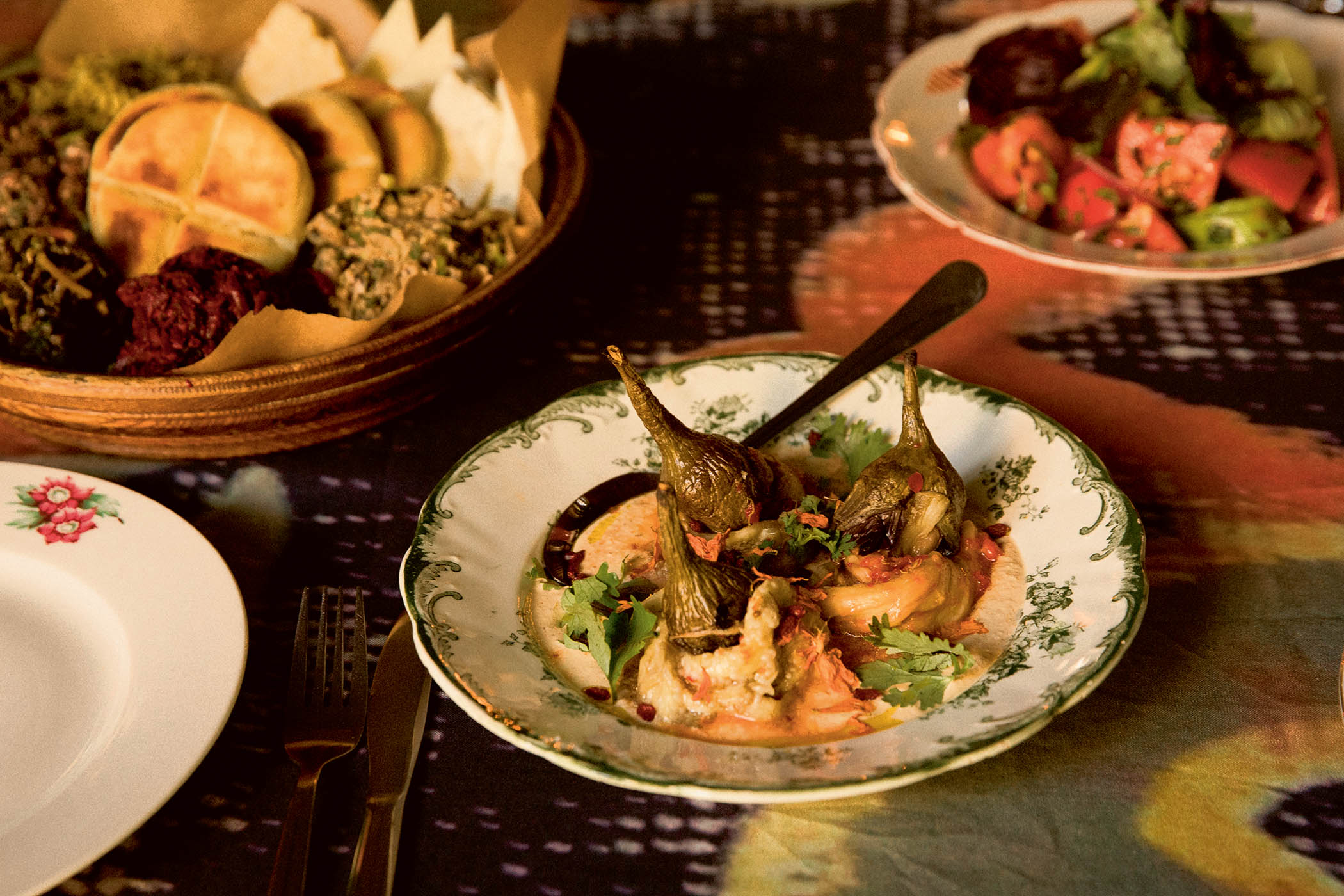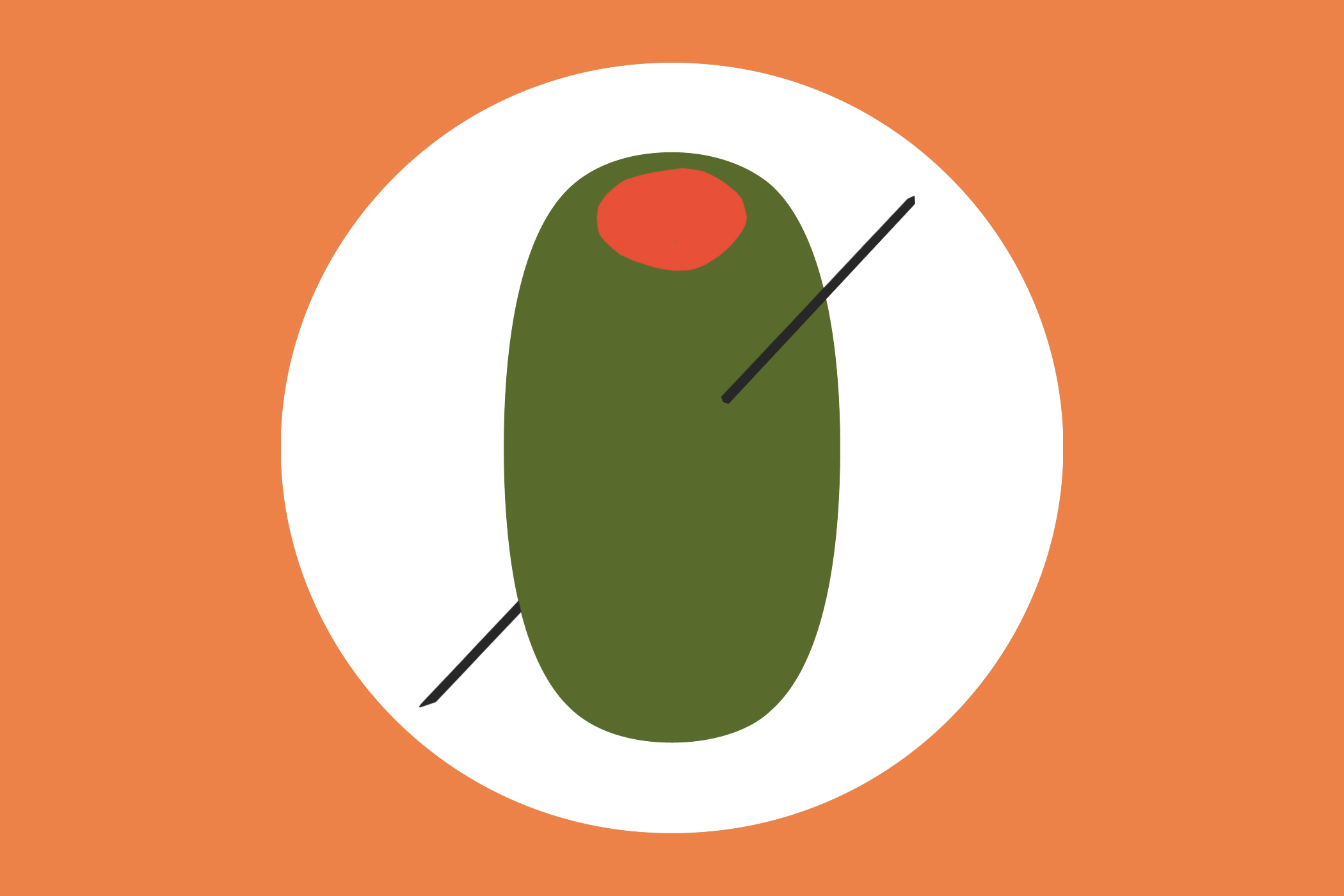Photographs Elena Heatherwick
You hold a melon to your ear and tap it,” says Giorgi Mindiashvili, showing me the method his grandmother taught him. “I know from the noise how full or empty it is – and how sweet.” We’re at Dezerter Bazaar in the Georgian capital of Tbilisi, and Mindiashvili – who owns five restaurants here and will open another, DakaDaka, in London in the next few months – is helping me choose produce.
Somewhat unusually for this market, this is a general fruit stall. Elsewhere, hawkers specialise. We’ve met Narmira, who has been selling cabbages here from the back of her van for 10 years; Narite, who nurses a towering table of herbs, from luscious stems of dill flecked with yellow umbels to the peppery purple basil so ubiquitous in Georgian salads; and Shorena who sells tomatoes – the big, hunky kind that love to be skinned and married with onions and walnuts (there’s also a vendor for each of them). There is a stall for every ingredient that Georgian cuisine holds dear at Dezerter, and a joyful but deeply serious energy to the place.

‘I know from the noise how full the melon is – and how sweet’: Giorgi Mindiashvili checks if a melon is ripe the way his grandmother showed him, in Tbilisi's Dezerter Bazaar market
Nestled in the southern Caucasus alongside Armenia and Azerbaijan, Georgia is a valley of a country that has always occupied a kind of mythic status in my imagination. Its isolation under Soviet occupation (1921-1991) contributed to its enigma, but more so its geography on the hinge of east and west. It is hemmed in by the Black and Caspian Seas, and by mountain ranges where shaggy sheep graze at unlikely gradients and stratus clouds obscure the view. For those who live here, “There is no crossing between the ranges,” says Mindiashvili. “You always come back to the valley to move between them.” Meanwhile, for you and me, getting to Georgia from the UK was convoluted until recently. That changed this year with the arrival of BA and easyJet’s direct flights to Tbilisi from London.
Georgian flavours – the grippy amber wines and the cheesy breads and sour-sweet salads so unlike anything else I’ve eaten – have long intrigued me, and I’ve come here with Mindiashvili and chef Mitz Vora, his partner in DakaDaka, for a four-day odyssey to see and taste the food and wine in context. On day one, we head north out of Tbilisi and into the Alpine heights of Kazbegi, the last inhabited place this side of Russia. As we ascend, our driver, surly Sulhan (to make him smile is a day’s triumph), plays Chakrulo, a choral polyphonic folk song. The music speaks to the landscape, which steals breath with its ravines, its peaks and, as we move closer to the sun, with a light that bathes even roadside toilet stops in romance.
Related articles:
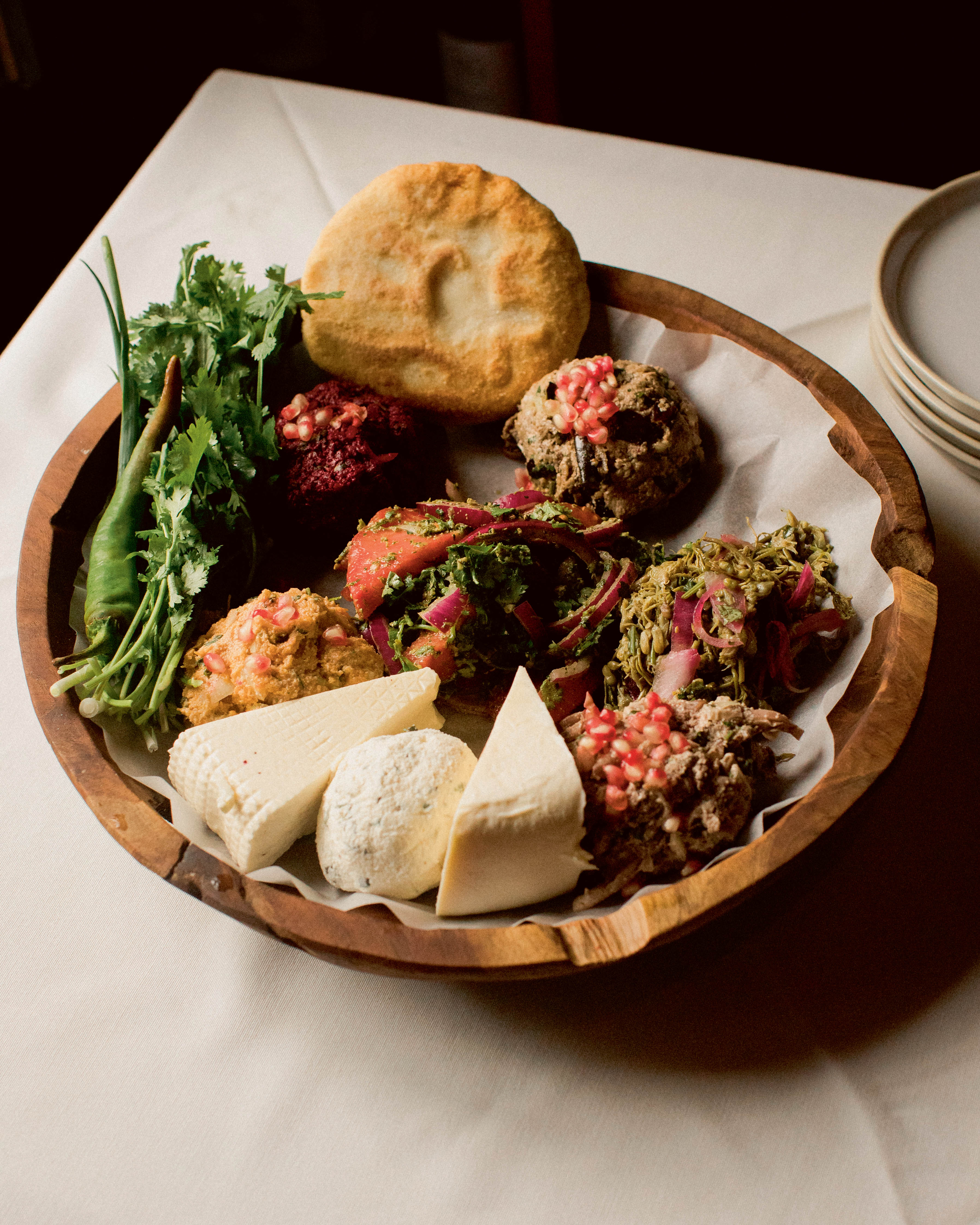
An orchestra of Caucasian flavours’: a platter of seasonal pkhalis, cheeses, herbs and cornbread at Doli restaurant in Kutaisi
We stop for lunch in Pasanouri village, as many skiers do, for a meal of khinkali, little dumplings with fillings that vary by region (here, cheese curds and caraway is a speciality). Khinkali originated in northern Georgia and we’ve come to Guda, a restaurant that’s made an art out of them. In the kitchen, two women in hairnets are hard at work on a production line, one on a dough sheeter, rolling the dough into rounds of optimal thickness, the other filling them with lamb mince seasoned with wild thyme before folding, twisting and sealing them into sacks ready to be steamed. Known as kuchi or “navels”, their tops, like outward bellybuttons, are for you to hold the dumpling as you eat the filled dough beneath.
Our own bellies full, we continue our journey through the Truso valley, past fields of wild grasses littered with beehives in many colours, and distant hills where shepherds work on necessarily short-legged ponies, and up to Kazbegi, where the tallest peaks reach 5,000m. Here we stay at Rooms, a Soviet-era sanatorium turned chic hotel with rooms at £110 per night and panoramic views of Mount Kazbek and the valley’s cluster of chalets from its terrace, pool, sauna and bedrooms, windows framing the snow-capped peaks into living art.
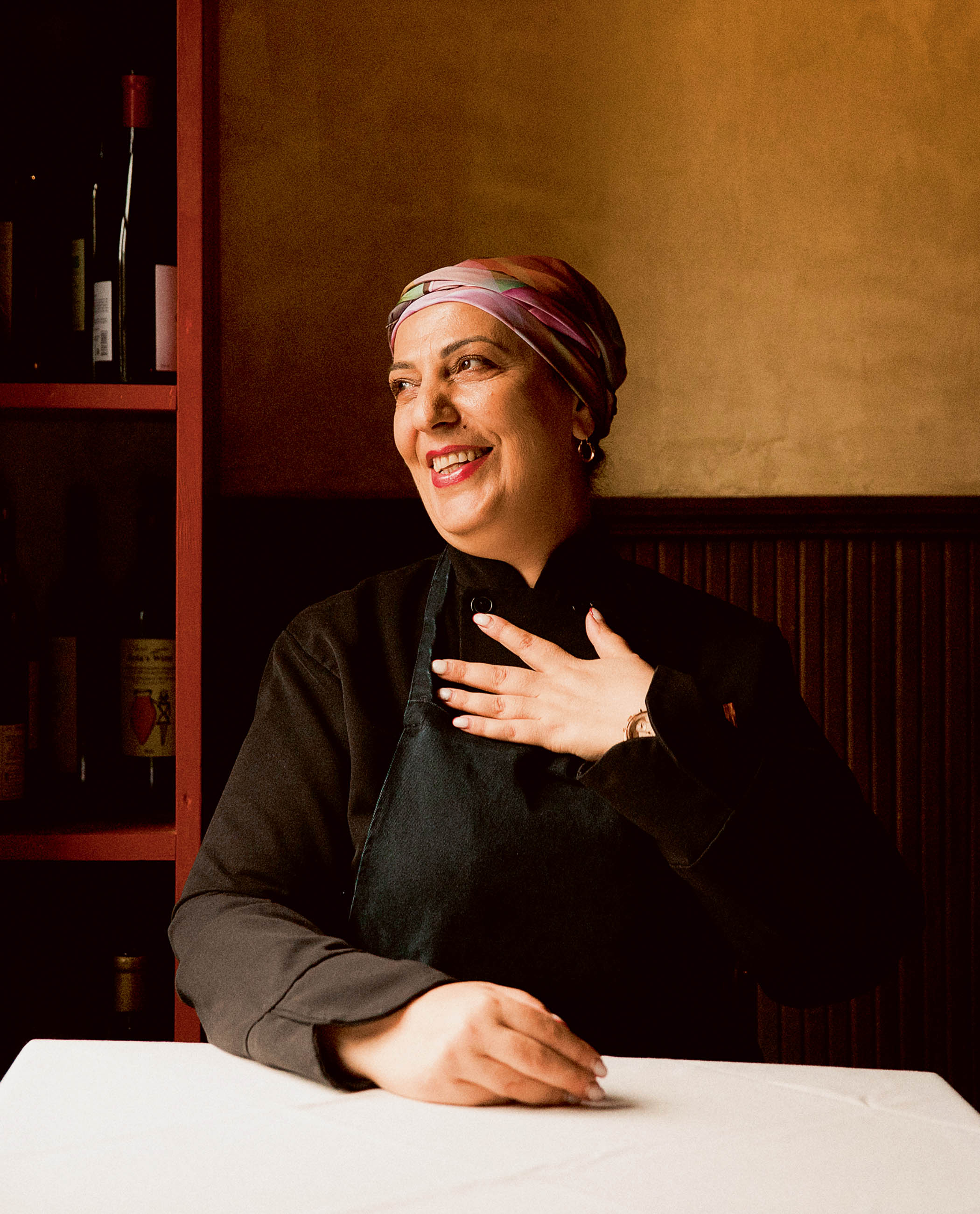
Communal hotel chef Maka
Across the valley from the hotel is Gergeti, a village crowned with an Orthodox church at its highest point, and where we are headed for dinner, to Maisi, a restaurant that we’ve heard has a modern take on traditional Georgian food. It’s run by a young couple out of what looks like a hut. We walk there and, en route, I dreamily take a picture of a shepherd at dusk; he swears at me in Russian, because he assumes that’s what I am, Mindiashvili explains.
It is just one example of the widespread antipathy towards Georgia’s one-time occupiers. On the door of one restaurant, we see the sign: “By entering OUR restaurant you agree that PUTIN is a WAR CRIMINAL and respect the territorial integrity of Georgia Ukraine and Moldova #Russiaisanoccupier #StopRussia.” Mindiashvili remarks that “We are very protective of our identity,” adding that Russia was just the latest in a string of occupiers (among them Arabs, Turks, Romans) over the centuries. From the Soviet era to the Putinian present, Georgia’s recent history with Russia is thorny, but Mindiashvili says he appreciates some of what imperial Russia brought here, namely neoclassical architecture and desserts, thanks to the tsars’ French pastry chefs. But, he adds, “from a culinary standpoint, we’ve conquered them! If you want to take someone for dinner in Russia, you go for a Georgian meal.”
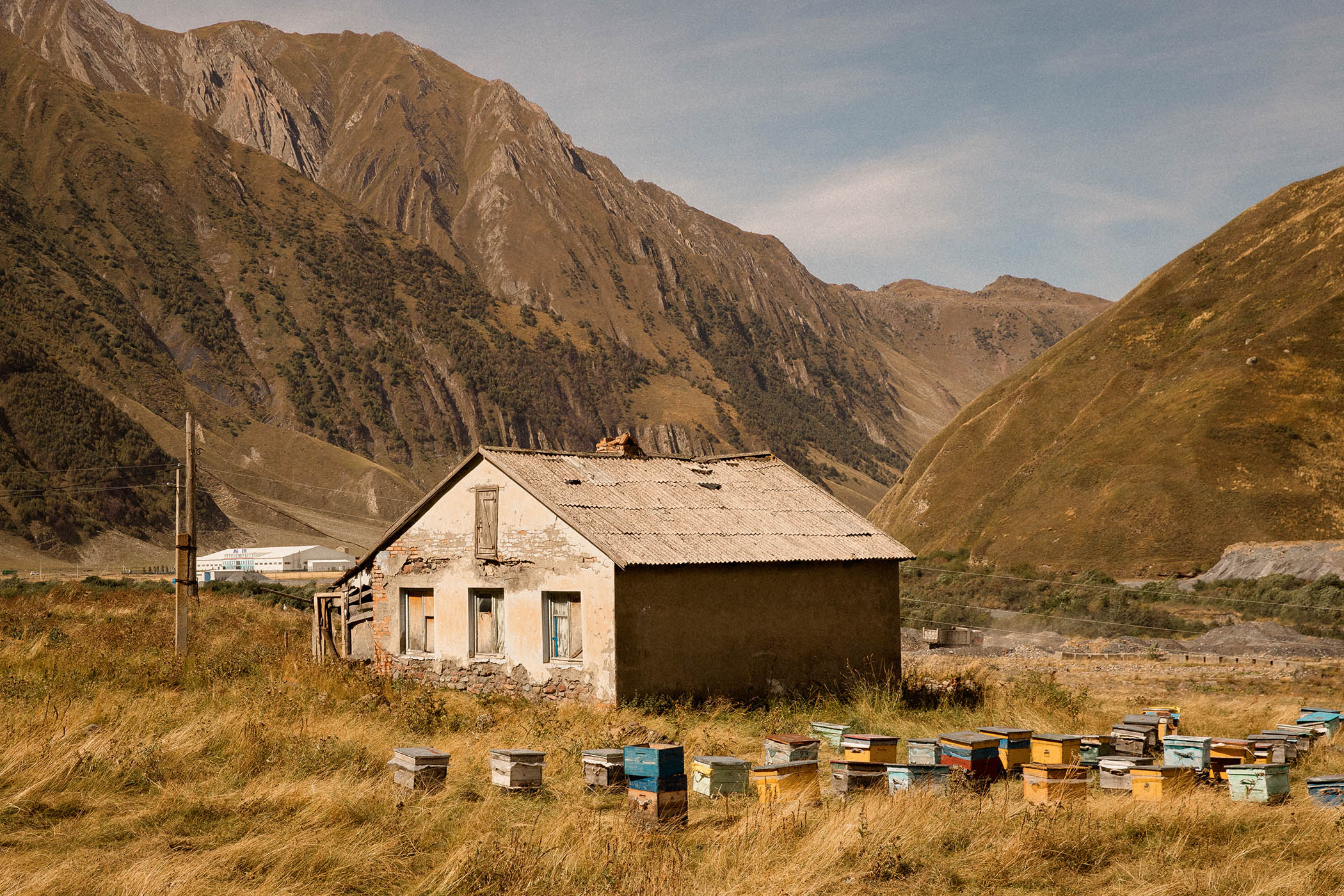
Beehives in Truso Valley, on the road from Tbilisi to Kazbegi
What is it about Georgian food that makes it so distinct? Partly the spices, says Vora, who explains the earthy trifecta of marigold, blue fenugreek and coriander which, if not always together, appear in almost every dish. Then, he says, there’s the use of walnuts: they appear everywhere from pkhali, a kind of dip/salad hybrid of whatever vegetables are in season, to churchkhela, or “Georgian Snickers”, a sweet snack which I initially mistake for sausage, where nuts on a string are dipped in thickened grape juice, then dried. And then there are the sauces: satsebeli (tomato and chilli), tkemali (sour plum) and spicy adjika, which can be red or green.
At Maisi, green adjika crowns pink tomatoes with purple basil and berry vinegar. In an open kitchen, chef Kato Vashakmadze and her team put together a spellbindingly original interpretation of Georgian fare: “nice leaves” are kale and rocket with pine cone mustard and barberry, while khachoerbo is a melted, aged cottage cheese with croutons and potatoes. Each year, they open for visitors when the elements allow (Mindiashvili was once snowed in at Rooms Kazbegi – although I can think of worse places to be stuck). The season usually runs from mid-May to November.
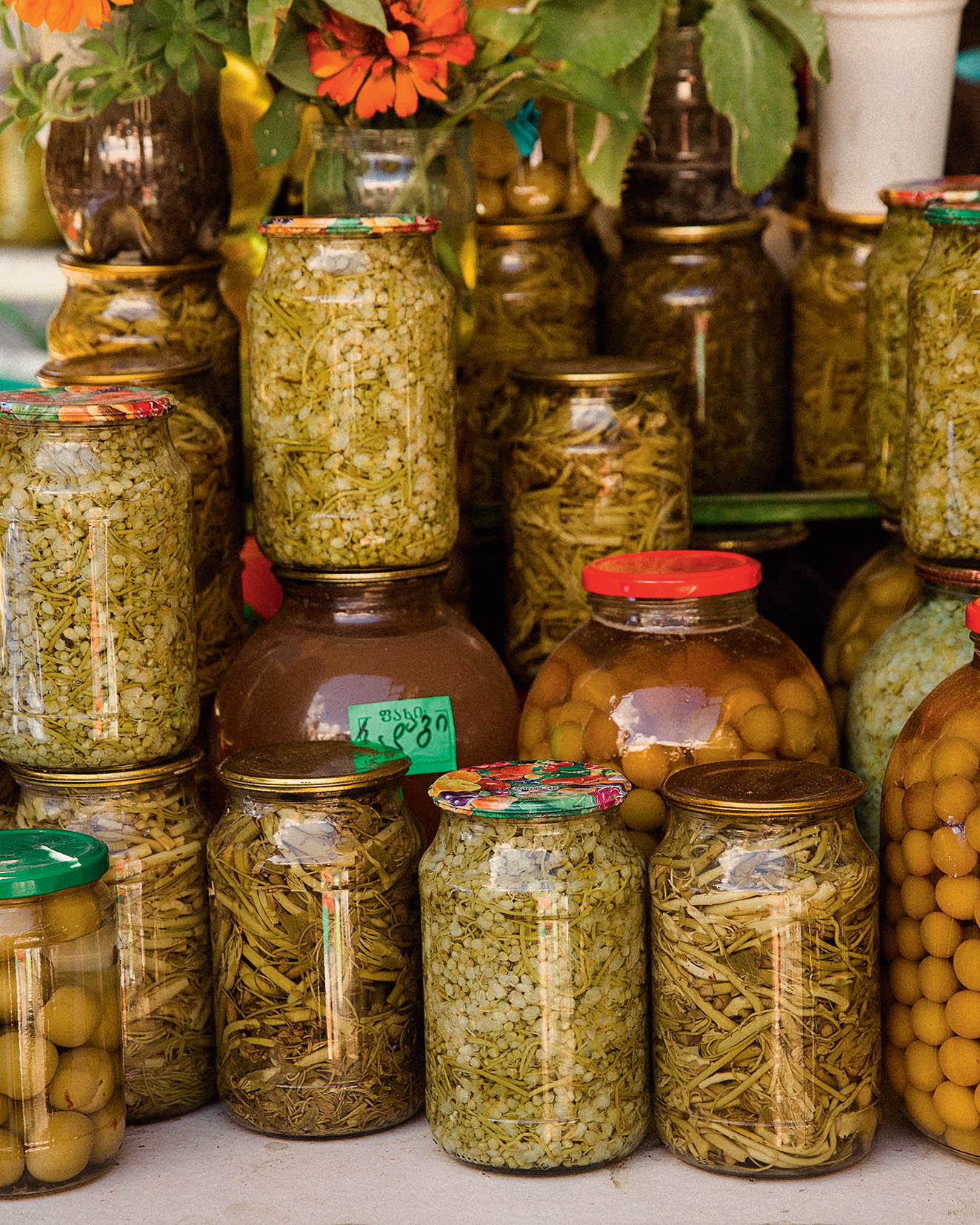
Jars of jonjoli, or pickled wild caper berries, at Dezerter Bazaar
“People expect to have wine with dinner,” says Mindiashvili. “They don’t get drunk, but they’ll have at least three glasses.” We laugh, but he does not; wine in Georgia is virtually a food, not least because it is usually aged in contact with grape skins, making it almost crunchy to drink. Food and wine harmonise like polyphonia, and we taste this for ourselves the next day when we head west to the wine-producing area of Imereti.
At Archil Guniava’s winery, we have lunch courtesy of Tsiuri, his wife. We try khachapuri, or Georgian “cheese bread” in which a simple dough explodes with local cheese, mushrooms fried with minced walnuts and vinegar, and a tomato salad with piquant purple basil. Guniava is pouring his latest vintage of Dzelshavi, an indigenous red grape that was outlawed under Soviet rule (they narrowed Georgia’s hundreds of wine grapes down to 45 to boost productivity of mass table wines). He siphons the wine from a hole in the ground – it is ageing in a traditional clay pot, or qvevri – and releases it into glasses. I take a sip and it is at once savoury, fruity and herbaceous. It echoes the meal, the food and drink, an orchestra of Caucasian flavours.
‘From a culinary standpoint, we have conquered Russia’
Georgia is often considered the “cradle” of winemaking, and in 2017 some 8,000-year-old clay pots, like those used by Guniava, were uncovered in the country’s southeast. It is also home to the supra, a Dionysian multi-course feast that celebrates life, history and togetherness with countless toasts and polyphonic singing. Tourists visiting the western vineyards of Imereti tend, like us, to base themselves in Kutaisi, once the Georgian capital and now a trove of medieval history, including Bagrati cathedral, a former Unesco world heritage site.
We stay at Communal, Mindiashvili’s small 10-room hotel, which is housed in an old musician’s residence. It has a kind of crumbling beauty and still feels like a home, especially with chef Maka in the kitchen at Doli, which defies my prejudice about hotel restaurants – not least because, like everywhere we eat, it is so affordable. “Any time I cook anything in a bad mood, it translates to taste,” she says, from which I deduce that she’s the happiest person alive. Her gobi, a wooden platter of fresh Georgian goodness – local cheese and cornbread, pumpkin, beetroot and aubergine pkhalis, herbs, tomatoes and a hefty nest of pickled caper flowers, known as jonjoli – will stay with me forever.
Back at Dezerter Bazaar on our last day in Tbilisi, my shopping list is long. I give up on melons, but still head to the airport with an ambitious haul: tomatoes and cucumbers to nurse like babies in my hand luggage, and a hold case of adjika and tkemali, four bottles of wine and a large and beautiful jar of jonjoli, which I wrap in the nappies my photographer accomplice had the foresight to bring.
Capital cuisine: three great foodie destinations in Tbilisi
Craft In the artsy neighbourhood of Plekhanovi, this restaurant and wine bar is housed in what was once Alexandre Dumas’s Tbilisi bedroom. Expect a sumptuous introduction to Georgian cooking with playful flourishes: barbecued celeriac with strained buffalo yoghurt, kidney bean hummus, and a host of seasonal pkhalis served with slow-fermented lavash bread baked in wood ovens. You’ll find wines from across the country; try narrowing things down by region or, even better, ask about their wines from women winemakers.
Stamba Located in a Soviet-era publishing house, Stamba is more than a boutique hotel. It is a cultural hub. Here you will find a bookshop, an exhibition space, a restaurant in Café Stamba, a chocolate maker and coffee roastery, and Warehouse Tbilisi, which has an exhaustive selection of natural wines. Sit in for a tasting or buy a bottle to go: either way, make sure you see the hotel lobby.
Shavi Lomi Named after a painting of a black lion by Georgian artist Niko Perosmani, this restaurant feels like a temple to Georgian bohemia, but there’s doubtless something to delight everyone. Inside, it is a trove of artisanal textiles and antiques. It’s the place to come for a peerless gobi, but also unique takes on traditional cuisine.
